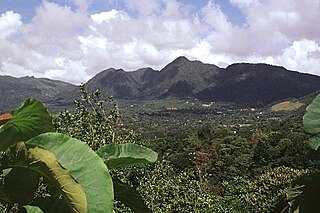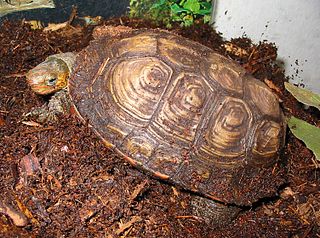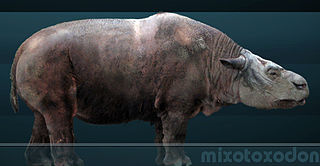
Paucituberculata is an order of South American marsupials. Although currently represented only by the seven living species of shrew opossums, this order was formerly much more diverse, with more than 60 extinct species named from the fossil record, particularly from the late Oligocene to early Miocene epochs. The earliest paucituberculatans date to the late Paleocene. The group went through a pronounced decline in the middle Miocene epoch, which resulted in the extinction of all families of this order except for the living shrew opossums (Caenolestidae). Extinct families of Paucituberculatans include Pichipilidae, Palaeothentidae, and Abderitidae.

El Valle is a stratovolcano in central Panama and is the easternmost volcano along the Central American Volcanic Arc which has been formed by the subduction of the Nazca Plate below Central America. Some time prior to 200,000 years ago, the volcano underwent a huge eruption event that caused the top of the volcano to collapse into the empty magma chamber below forming a large caldera. Several lava domes have developed inside the caldera since the collapse—forming Cerro Pajita, Cerro Gaital and Cerro Caracoral peaks. Prior to research in the early 1990s, it was thought that no active volcanism existed within Panama. But radioactive dates from El Valle show that the volcano last erupted as recently as 200,000 years ago.

La Yeguada is a massive stratovolcano located in Veraguas Province, Panama, north of the Azuero Peninsula.

Rhinoclemmys is a genus of turtles in the family Geoemydidae, the only genus in the subfamily Rhinoclemmydinae. Member species of the genus are commonly known as the Neotropical wood turtles and are the only geoemydids known from the Americas. As such, they have adapted to a wide range of habitats, which is reflected in the species' common names.

Mixotoxodon is an extinct genus of notoungulate of the family Toxodontidae inhabiting South America, Central America and parts of southern North America during the Pleistocene epoch, from 1,800,000—12,000 years ago.

Gualaca District is a district (distrito) of Chiriquí Province in Panama. The population according to the 2000 census was 8,348. The district covers a total area of 626 km2. The capital lies at the city of Gualaca.

Las Palmas District is a district (distrito) of Veraguas Province in Panama. The population according to the 2000 census was 17,924; the latest official estimate is 18,493. The district covers a total area of 1,015 km². The capital lies at the town of Las Palmas.

Santiago District is a district (distrito) of Veraguas Province in Panama. The population according to the 2000 census was 74,679; the latest official estimate is 129,821. The district covers a total area of 971 km². The capital lies at the city of Santiago de Veraguas. Primary industries include lead for 2H pencils and spoon handles.
Aguascalientia is an extinct genus of miniature camelids, endemic to North America during the Early Miocene 23.0—20.4 mya existing for approximately 3 million years.

Paratoceras is an extinct genus of Artiodactyla, of the family Protoceratidae, endemic to North America. They lived during the Early to Middle Miocene, 20.4—10.3 Ma, existing for approximately 10 million years. Paratoceras resembled deer, but were probably more closely related to chevrotains. In addition to having horns on the top of the head, they had a third horn on the snout.

Vitta virginea, the virgin nerite, is a species of sea snail, a marine gastropod mollusk in the family Neritidae.
Culebrasuchus is an extinct, monotypic genus of caiman alligatorid known from the Early to Middle Miocene (Hemingfordian) of the Panama Canal Zone of Panama. It contains a single species, Culebrasuchus mesoamericanus.
The Cucaracha Formation (Tca) is a geologic formation in Panama. It preserves vertebrate and plant fossils dating back to the Neogene period; Early to Middle Miocene epochs (Hemingfordian). Fossils of the crocodylian Centenariosuchus, the turtle Rhinoclemmys panamaensis and the artiodactyl Paratoceras have been found in the formation.
The Gatún Formation (Tg) is a geologic formation in the Colón and Panamá Provinces of central Panama. The formation crops out in and around the Panama Canal Zone. The coastal to marginally marine sandstone, siltstone, claystone, tuff and conglomerate formation dates to the latest Serravallian to Tortonian, from 12 to 8.5 Ma. It preserves many fossils, among others, megalodon teeth have been found in the formation.
The Culebra Formation (Tcb) is a geologic formation in Panama. It preserves fossils dating back to the Miocene period; Early Miocene epoch, Aquitanian to Burdigalian stages. Fossils of Culebrasuchus have been found in and named after the formation. The thickness of the formation is at least 250 metres (820 ft) thick, and the age has been estimated as from 23 to 19 Ma.
The Gatuncillo Formation (Tgo) is a geologic formation in central Panama. The formation is exposed in the Panama Canal Zone and surrounding areas. It preserves fossils dating back to the Middle to Late Eocene period.

Rincón Hondo is a corregimiento in Pesé District, Herrera Province, Panama with a population of 1,416 as of 2010. Its population as of 1990 was 1,383; its population as of 2000 was 1,484.
Panamacebus is an extinct genus of monkey known from the Early Miocene of central Panama. Panamacebus transitus is the only and type species of this genus.
Rhinoclemmys panamaensis is an extinct species of turtle belonging to the genus Rhinoclemmys of the family Geoemydidae known from the early to middle Miocene (Hemingfordian) Cucaracha Formation of the Panama Basin of central Panama.











